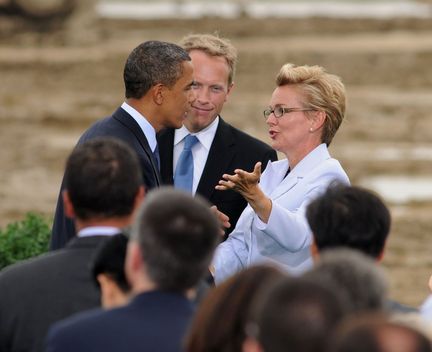
Given the dearth of new economic strategies that make sense and actually work, it’s appropriate to again take note of what’s happening here in my home state of Michigan around clean energy development. The more you think about it, the clearer the significance of what Governor Jennifer Granholm (with the president in pix above at July 15 groundbreaking of a new lithium-ion battery plant in West Michigan) has accomplished becomes clearer and clearer.
In short, one of the important and unsung low-carbon economy success stories in the United States, one that’s been shaped by a fortunate convergence of state and federal investment, is rapidly taking shape in Michigan. More than 40 new plants have been built, are under construction, or approaching ground-breaking to manufacture components for wind and solar energy, and to scale up Michigan’s electric vehicle sector, particularly the construction of new manufacturing plants to make dense, powerful lithium ion batteries.
Some $9 billion has been invested — $6 billion for next generation electric vehicles, $3 billion for solar, wind, and other energy alternatives – which represents a mix of private capital, state tax incentives, and federal grants from the 2009 American Recovery and Reinvestment Act. Gov. Granholm asserts that the first phase of the state’s industrial redevelopment already has produced over 3,000 new jobs and will soon produce 86,000 more.
Senate Failure, Michigan Advances
This morning, just days after Senate Majority Leader Harry Reid announced that action on a proposed Oil disaster response bill would not occur at least until September, and advocates worried it may not happen at all, Gov. Granholm appeared at a clean energy briefing in Washington at the Center For American Progress. She was asked what she would do to advance comprehensive national climate and energy legislation.
“We have to get off the debate about whether global warming is occurring,” said the two-term Democratic governor. “We have to talk about jobs.”
She added: “Assume that the 132 countries that made commitments to cut their emissions are serious. Assume that those countries have analyzed the jobs that are inherent to do that. Then the best argument is about jobs for America. We need all kinds of jobs for all kinds of people. We are turning our back on this opportunity. Let’s just talk about the opportunity for jobs.”
Over the last eight weeks, as the work to achieve a comprehensive national climate and energy policy devolved from President Obama’s “new national mission” to no bill at all, the reasons for the collapse have been turned over and again like a compost pile.
It’s Jobs Stupid
The environmental community mounted a multi-faceted campaign in and outside Washington to accomplish its goal of cooling the planet. It hasn’t worked at the federal level. Gov. Granholm’s advice is to focus on heating up the economy.
We ought to think hard about embracing the counsel more than we have. Michigan has served for years as a warning sign for the economic and social dysfunction that occurs when major industries and government utterly fail to keep pace with changing markets. It still has the second highest unemployment rate in the nation.
Yet since the signing of the federal stimulus bill in February 2009, the state has emerged, arguably, as the nation’s clearest example of the real progress that can be made in job growth, modernization, and carbon emissions reductions when industry and government collaborate to command a new market.
In a nation where people care most about either finding or hanging on to a good job, isn’t that the best way to reach voters and the political leaders who represent them?
— Keith Schneider